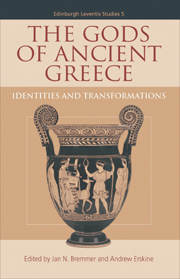Book contents
- Frontmatter
- Contents
- Preface
- List of Illustrations
- Notes on Contributors
- List of Abbreviations
- Introduction: The Greek Gods in the Twentieth Century
- 1 What is a Greek God?
- PART I SYSTEMATIC ASPECTS
- PART II INDIVIDUAL DIVINITIES AND HEROES
- 8 Zeus at Olympia
- 9 Zeus in Aeschylus: the Factor of Monetization
- 10 Hephaistos Sweats or How to Construct an Ambivalent God
- 11 Transforming Artemis: from the Goddess of the Outdoors to City Goddess
- 12 Herakles between Gods and Heroes
- 13 Identities of Gods and Heroes: Athenian Garden Sanctuaries and Gendered Rites of Passage
- PART III DIACHRONIC ASPECTS
- PART IV HISTORIOGRAPHY
- Epilogue
- Index
10 - Hephaistos Sweats or How to Construct an Ambivalent God
from PART II - INDIVIDUAL DIVINITIES AND HEROES
Published online by Cambridge University Press: 05 August 2013
- Frontmatter
- Contents
- Preface
- List of Illustrations
- Notes on Contributors
- List of Abbreviations
- Introduction: The Greek Gods in the Twentieth Century
- 1 What is a Greek God?
- PART I SYSTEMATIC ASPECTS
- PART II INDIVIDUAL DIVINITIES AND HEROES
- 8 Zeus at Olympia
- 9 Zeus in Aeschylus: the Factor of Monetization
- 10 Hephaistos Sweats or How to Construct an Ambivalent God
- 11 Transforming Artemis: from the Goddess of the Outdoors to City Goddess
- 12 Herakles between Gods and Heroes
- 13 Identities of Gods and Heroes: Athenian Garden Sanctuaries and Gendered Rites of Passage
- PART III DIACHRONIC ASPECTS
- PART IV HISTORIOGRAPHY
- Epilogue
- Index
Summary
In a seminal 1978 article on Aphrodite and Persephone in Locri, the late Christiane Sourvinou-Inwood (1945–2007) broke new ground by raising the problem of the relationship between the local and Panhellenic persona of a Greek divinity. However, this is only one aspect of Greek polytheism. In addition to the relationship between the local and Panhellenic persona, we also have to think about the relations between the various gods as they are reflected in the divine pecking order: which gods are more important than others and how we can distinguish these hierarchies. By paying close attention to the ways the Greeks represented the divine hierarchy, we may gain insights into the manner in which they perceived and constructed their own human world. As a small contribution to this project I would like to offer some thoughts about Hephaistos, who is well known as a maker of important and beautiful objects (see below), but nevertheless was not a very important god in historical times. I will be mainly concerned with the manner in which the Greeks constructed his divine persona and the means by which they indicated his low status. We will conclude with some observations on possible inferences from this divine representation for a better understanding of his human worshippers.
- Type
- Chapter
- Information
- The Gods of Ancient GreeceIdentities and Transformations, pp. 193 - 208Publisher: Edinburgh University PressPrint publication year: 2010

